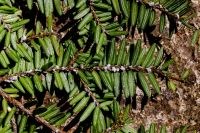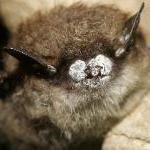
NPS Photo/Jesse Wheeler. Insects alter forest ecosystems in major ways including defoliating and depriving trees of nutrients, which in turn affects all other organisms reliant on that forest type, or community. Some of these pests and diseases have existed in the area before humans. These are called 'endemic' or 'native.' 
NPS Photo Forest Pests & PathogensHemlock Woolly AdelgidThe hemlock woolly adelgid (Adelges tsugae) is an aphid-like invasive insect that was first found in Acadia National Park in 2022. This pest of Eastern hemlock (Tsuga canadensis) has caused widespread damage to forest ecosystems throughout the eastern United States and Canada. Acadia's species profile on hemlock woolly adelgid provides identification and contact information for visitors to report sightings.Emerald Ash BorerThe emerald ash borer (EAB) is an invasive forest pest that was first detected in Maine in 2018. This wood-boring beetle causes mortality of white ash (Fraxinus americana), the most common ash species in Acadia, as well as green ash (F. pennsylvanica) and brown ash (F. nigra). Brown ash is a cultural keystone species for Wabanaki peoples and essential to the tradition of basketmaking.EAB adults are emerald green, under ½ inch long, and active from June to August. EAB larvae (1.5” long) tunnel through the host tree’s conductive tissue, preventing the flow of water and nutrients. The S-shaped galleries formed by larvae essentially girdle the tree and can cause mortality within 3-5 years. EAB is primarily spread by moving infested wood products. In areas where it has been detected, any ash wood could be infested even if there are no visible signs. Take precautions to slow the spread of this and other invasive species, including purchasing and burning firewood locally and avoiding cutting ash trees or moving wood when EAB is most active. The highest risk of spread is from May 1st to October 1st. Acadia’s Vegetation Program participates annually in a statewide monitoring network for EAB, which has not yet been found in the park. Signs and symptoms of EAB include areas of bark loss due to woodpeckers feeding on EAB (blonding), S-shaped galleries, D-shaped exit holes (1/8 inch wide), and sprouting from the base of the trunk. Report potential sightings to the Maine Forest Service and visit maine.gov/eab for more resources. Red Pine ScalePark staff and nearby residents have observed red pine declining in health in and around Acadia for more than a decade, but we only discovered the cause in 2014.The invasive red pine scale (Matsucoccus matsumurae), also known as Japanese pine bast scale, was detected near Norumbega Mountain in the town of Mount Desert and Acadia National Park in September, 2014 . This was the first known occurrence in the State of Maine.The red pine scale insect is native to Japan but arrived in the United States in 1946. The scale insect is about the size of a pin-head and covers itself with a protected white woolly substance that is visible on branches.NPS managers at Acadia are removing dead pines that pose a hazard along roads, trails and parking lots. Ecologists recommend keeping standing dead pines that are not hazards to allow them to break down naturally. They provide good wildlife habitat and return nutrients to forestbsoils. While red pine trees is not the dominent conifer tree in Acadia National Park, the large swaths of dead red pine trees have changed Acadia's forests forever. Browntail MothThe browntail moth (Euproctis chrysorrhoea) is an invasive forest pest that impacts both human and forest health. Exposure to the toxic hairs produced by browntail moth caterpillars can lead to skin rash and respiratory problems if inhaled. The risk of exposure is greatest between April and July.Beech Leaf DiseaseBeech leaf disease is an emerging threat to American beech (Fagus grandifolia) that was first documented in Acadia National Park in 2022.It is associated with a parasitic nematode (Litylenchus crenatae mccannii), one of several pathogens and pests impacting beech trees across eastern North America. This species feeds on leaf buds of many beech species, including the native American beech as well as European beech (Fagus sylvatica) and other cultivars. Damage to leaf buds in early spring produces banded, crinkled, or leathery leaves, but severe infestations can kill buds before leaf-out. The early loss of damaged leaves and thinning of the canopy over several years leads to decline and mortality, especially in younger trees. 
NPS Photo DiseasesWhite Nose Syndrome in BatsBats are an important part of ecosystems and food webs. Though some species of bats feed on fruit, seeds, or pollen, all of the species that live in Acadia are insectivores. They consume huge numbers of insects every night, filling a unique ecosystem role as nocturnal insect predators. Unfortunately, a new disease called white-nose syndrome is affecting Acadia's bats. White-nose syndrom is caused by a fungus called Pseudogymnoascus destructans. Researchers have learned WNS is spread from bat to bat when they touch and also from cave surfaces to bats. Scientists also think that humans have the potential to carry the fungus from cave to cave, increasing the rate of spread.Highly Pathothogenic Avian Influenza in SeabirdsBats are an important part of ecosystems and food webs. Though some species of bats feed on fruit, seeds, or pollen, all of the species that live in Acadia are insectivores. They consume huge numbers of insects every night, filling a unique ecosystem role as nocturnal insect predators. Unfortunately, a new disease called white-nose syndrome is affecting Acadia's bats. White-nose syndrom is caused by a fungus called Pseudogymnoascus destructans. Researchers have learned WNS is spread from bat to bat when they touch and also from cave surfaces to bats. Scientists also think that humans have the potential to carry the fungus from cave to cave, increasing the rate of spread.Invasive AnimalsAsian Shore CrabOn September 19, 2019, a student participating in the Marine Investigations program as part of the Schoodic Education Adventure (SEA) discovered the molted shell of an Asian shore crab (Hemigrapsus sanguineus), marking the first known detection of this invasive species within Acadia National Park. Originating from East Asia, the Asian shore crab has been steadily spreading across the Atlantic coast, where its population and ecological impacts continue to increase and is being monitored by park staff for a potential growing presence. This species joins the European green crab (Carcinus maenas), one of the world’s most notorious invasive species, as a non-native and invasive presence in Acadia's waters.Learn More About Pests, Diseases, & Invasive Animals at Acadia |
Last updated: April 3, 2025
